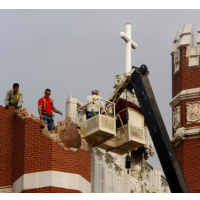Fracking Waste Injection Wells Linked to 60% of Earthquakes in Central and Eastern U.S.
 Damage from a 5.0 quake in Shawnee, Oklahoma, 2011 (photo: Sue Ogrocki, AP)
Damage from a 5.0 quake in Shawnee, Oklahoma, 2011 (photo: Sue Ogrocki, AP)
Fracking wells in the central and eastern United States have been linked to more than 60% of the earthquakes examined in those regions.
Researchers at the University of Colorado Boulder found that of the underground wells associated with earthquakes, 66% were used for oil recovery, a type of injection well. Other wells, those involving saltwater disposal, were 1.5 times as likely as oil recovery wells to be associated with earthquakes.
They also determined that “high-rate” injection wells were more often associated with earthquakes than wells with lower-rate injection. High-rate wells pump in excess of 300,000 barrels of wastewater into the ground per month. Thousands of injection wells in operation during the past few decades have not appeared to trigger an increase in seismic activity. It is only the more recent, high-rate injection wells that have done so, reported the researchers.
The study, published in Science, said there has been a dramatic increase in the rate of earthquakes in the central and eastern U.S. since 2009, and that earthquakes associated with injection wells have “skyrocketed from a handful per year in the 1970s to more than 650 in 2014,” the university reported.
The study area included 180,000 injection wells, of which 10%—primarily in Oklahoma and Texas—were determined to be associated with earthquakes. Seventy-seven percent of those associated wells remain active.
Among the earthquakes studied, there were several of significant magnitude—registering between 4.7 and 5.6—that occurred in 2011 and 2012 in Prague, Oklahoma; Trinidad, Colorado; Timpson, Texas; and Guy, Arkansas.
“This is the first study to look at correlations between injection wells and earthquakes on a broad, nearly national scale,” lead study author and doctoral candidate Matthew Weingarten of CU-Boulder’s geological sciences department said. “We saw an enormous increase in earthquakes associated with these high-rate injection wells, especially since 2009, and we think the evidence is convincing that the earthquakes we are seeing near injection sites are induced by oil and gas activity.”
-Noel Brinkerhoff, Danny Biederman
To Learn More:
High-Rate Injection Is Associated with the Increase in U.S. Mid-Continent Seismicity (by M. Weingarten, S. Ge, J.W. Godt, B.A. Bekins, J. L. Rubinstein, Science)
U.S. Mid-Continent Seismicity Linked To High-Rate Injection Wells (University of Colorado Boulder)
Scientists Strongly Link Fracking with Earthquakes in Texas and Oklahoma (by Noel Brinkerhoff and Steve Straehley, AllGov)
Oklahoma Scientists Agreed to Keep Quiet about Fracking-Earthquake Link for 5 Years (by Danny Biederman and Noel Brinkerhoff, AllGov)
- Top Stories
- Unusual News
- Where is the Money Going?
- Controversies
- U.S. and the World
- Appointments and Resignations
- Latest News
- Trump to Stop Deportations If…
- Trump Denounces World Series
- What If China Invaded the United States?
- Donald Trump Has a Mental Health Problem and It Has a Name
- Trump Goes on Renaming Frenzy






Comments